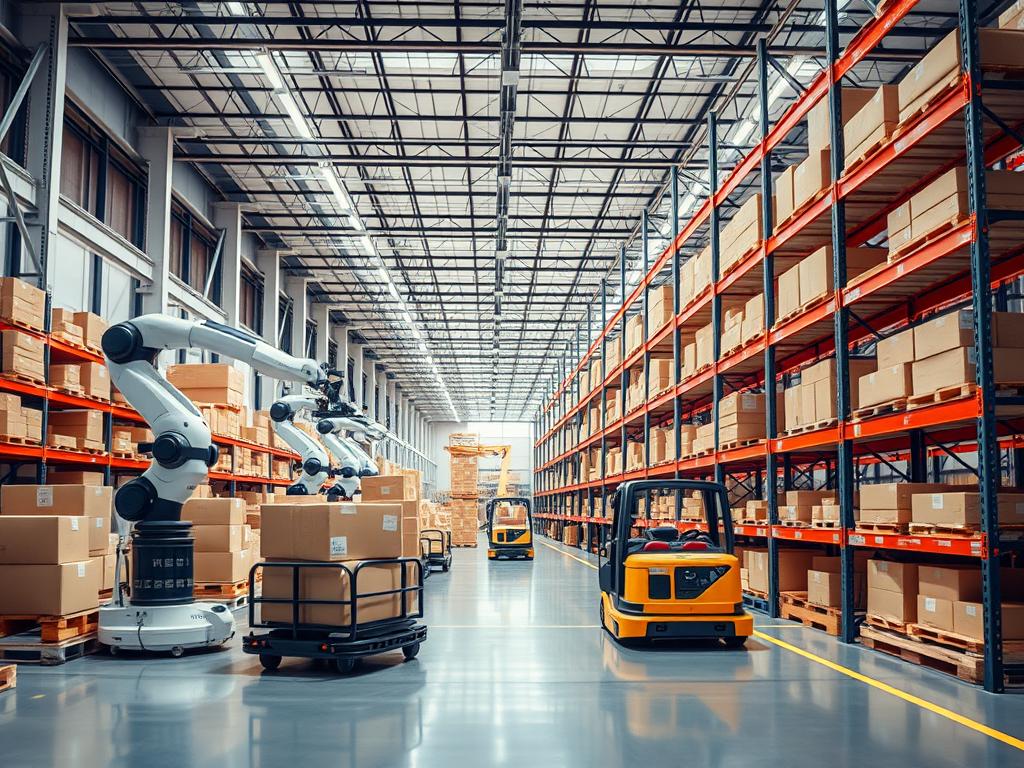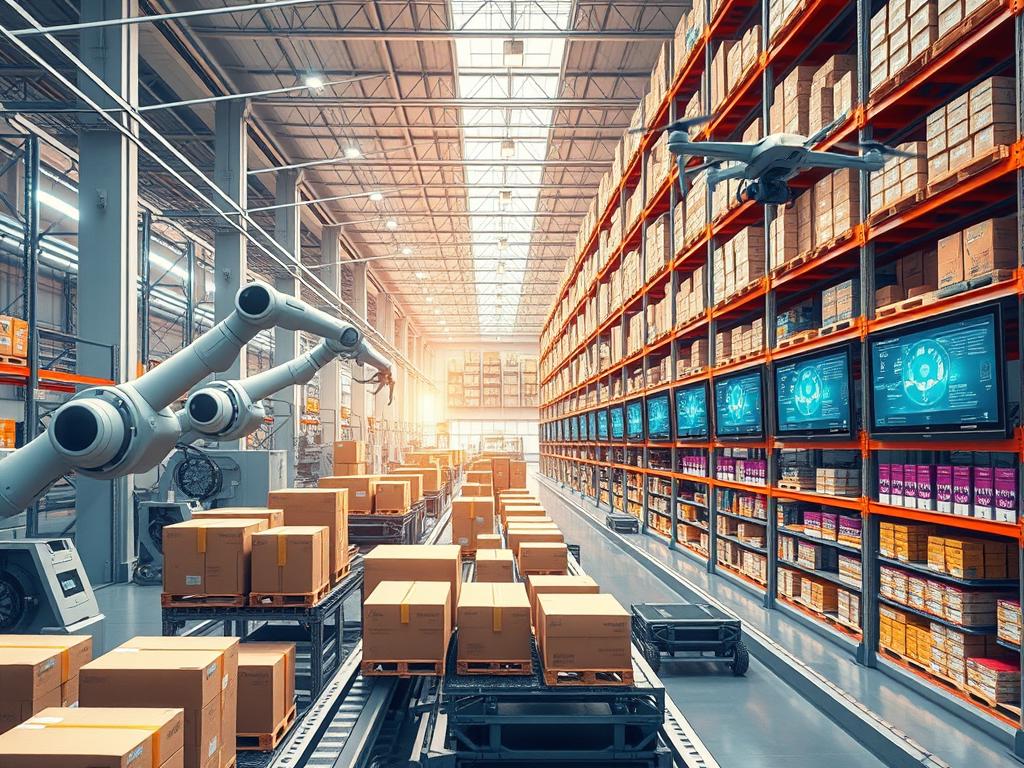Over 80% of U.S. warehouses operate without automation technology. This highlights the potential for growth in warehouse automation technologies. Businesses can use intelligent automation to optimize operations and meet customer demands.
Intelligent automation combines robotic process automation (RPA), AI, and machine learning. These systems transform warehouse operations, boosting efficiency and enhancing decision-making. They automate complex processes and improve overall business performance.
RPA and AI integration enables faster processing times and fewer errors. It also improves customer service in various industries. The business process management industry is expected to reach $15 billion by 2025.
Industries like banking, finance, healthcare, and retail are adopting these innovative solutions. Warehouse automation technologies are reshaping modern business operations. They pave the way for smarter and more efficient workflows.
Introduction to Warehouse Automation Technologies
Warehouse automation technologies are changing the logistics industry. These systems boost efficiency and transform warehouse operations. From robotics to advanced management systems, modern warehousing is evolving fast.
What Are Warehouse Automation Technologies?
Warehouse automation technologies optimize various processes. They include a range of innovative solutions for warehouses.
- Robotics in warehousing for picking and packing
- Automated storage and retrieval systems for efficient inventory management
- Warehouse management systems for real-time tracking and control
- Automated guided vehicles for seamless material transport

Importance of Automation in Modern Warehousing
Automation in warehouses is key to staying competitive. It offers many benefits to businesses.
| Benefit | Impact |
|---|---|
| Increased Efficiency | 40,000+ orders processed daily |
| Cost Reduction | Significant decrease in labor costs |
| Error Minimization | Higher accuracy in order fulfillment |
| Space Optimization | Improved storage utilization |
The global warehouse automation market is growing fast. It’s expected to reach $33.34 billion by 2026. This shows how important automation is becoming in modern warehousing.
Automation helps with faster processing and better inventory management. It also reduces errors in warehouse operations.
“Warehouse automation eliminates the need for human intervention through artificial intelligence, making processes more efficient and reducing errors.”
Warehouses are adopting these technologies to meet new challenges. They’re preparing for the demands of e-commerce and changing customer needs.
The future of warehousing depends on smart integration of automation solutions. This will help warehouses stay competitive and efficient.
Key Benefits of Implementing Automation Solutions
Warehouse automation offers numerous advantages to businesses. It boosts efficiency and cuts costs, transforming operations. Let’s explore the key benefits of automation in modern warehousing.
Increased Efficiency and Productivity
Automation solutions supercharge warehouse operations. Automated guided vehicles quickly move goods through aisles. Pick-to-light systems speed up order picking by guiding workers to items.
Voice-directed warehousing allows staff to work hands-free, increasing productivity. These tools create a seamless flow that outperforms traditional methods.
Cost Savings and Return on Investment
Automation’s upfront costs can be high, but long-term savings are substantial. These systems reduce labor costs and minimize errors, leading to significant operational savings.
Most logistics divisions see a return on investment within four to five years. This makes automation a smart choice for forward-thinking companies.
| Metric | Before Automation | After Automation |
|---|---|---|
| Labor Costs | High | Significantly Reduced |
| Productivity | Standard | Increased |
| Revenue Growth | Normal | Accelerated |
| Operational Costs | High | Reduced |
Improved Accuracy and Order Fulfillment
Automation greatly enhances accuracy in order fulfillment. Technologies like pick-to-light systems and voice-directed warehousing minimize human errors. This ensures customers receive the correct products.
Improved precision leads to higher customer satisfaction and fewer returns. As a result, the company’s bottom line sees a positive impact.

“Automation is not just about replacing human labor; it’s about augmenting human capabilities to achieve unprecedented levels of efficiency and accuracy in warehouse operations.”
By adopting automation solutions, warehouses can revolutionize their operations. This helps them stay competitive in today’s demanding market landscape.
Types of Warehouse Automation Technologies
Warehouse automation is changing the industry fast. It boosts efficiency and cuts costs. Let’s look at the key technologies behind this change.
Robotics and Automated Guided Vehicles (AGVs)
Robotics and AGVs are changing material handling. They can boost warehouse efficiency by 50-70%. These machines reduce manual labor and improve accuracy.
The AGV market is growing fast. It’s set to increase by 15.8% yearly from 2019 to 2025.
Warehouse Management Systems (WMS)
WMS are crucial in modern warehouses. In 2018, over 90% of warehouses used them. These systems coordinate operations and optimize inventory management.
WMS also work with warehouse execution systems for smooth workflows.
Automated Storage and Retrieval Systems (AS/RS)
AS/RS technologies save space and labor. They can reduce storage space by 85%. These systems also cut labor needs by two-thirds.
AS/RS achieve 99% pick accuracy. They work with warehouse control systems for maximum efficiency.
Internet of Things (IoT) Integration
IoT integration enables real-time tracking and data collection. It powers automated sorting systems. IoT also makes warehouses smarter overall.
The smart warehouse industry is growing fast. It’s expected to reach $77.8 billion by 2032.
| Technology | Key Benefit | Projected Growth |
|---|---|---|
| AGVs | 50-70% efficiency boost | 15.8% CAGR (2019-2025) |
| WMS | 90% adoption rate | 60% reduction in paper-based systems |
| AS/RS | 85% space savings | 99% pick accuracy |
| IoT Integration | Real-time tracking | $77.8 billion market by 2032 |
These technologies are making warehouses smarter and more efficient. By 2027, one in four warehouses will be automated. The future of logistics is becoming digital and streamlined.
Real-Life Applications in Various Industries
Warehouse automation is changing operations in many sectors. It boosts efficiency, cuts costs, and improves customer satisfaction. Let’s explore how industries use these innovative solutions.
Automotive Industry
The automotive sector uses automated storage and retrieval systems for managing parts inventories. These systems ensure quick access to components, reducing production delays. Automatic Guided Vehicles (AGVs) have proven safer and more efficient than manual labor.
E-commerce and Retail
Robotics in warehousing is crucial for order fulfillment in e-commerce and retail. Automated picking tools achieve near-perfect accuracy rates. Collaborative robots (cobots) work with humans to optimize workflows without major changes.
Pharmaceuticals
The pharmaceutical industry uses automated systems for precise inventory control and tracking. Warehouse management systems consolidate data for quick reporting and enhanced planning. These systems maintain strict quality control in drug manufacturing and distribution.
Food and Beverage
Food companies use automation for temperature-controlled storage and rapid order processing. Internet of Things (IoT) optimizes processes and inventory control in smart warehouses. This tech ensures food safety while meeting demanding delivery schedules.

| Industry | Key Automation Technology | Primary Benefit |
|---|---|---|
| Automotive | AS/RS | Efficient parts management |
| E-commerce | Robotics | Accurate order fulfillment |
| Pharmaceuticals | WMS | Precise inventory tracking |
| Food & Beverage | IoT | Temperature-controlled storage |
These examples show how effective warehouse automation is across industries. As businesses adopt these solutions, we’ll see more innovative uses. This will drive productivity and competitiveness across sectors.
Challenges and Considerations in Implementation
Warehouse automation technologies offer significant benefits but also present challenges. Companies must overcome these hurdles to maximize the potential of automated systems. Careful planning is essential for successful implementation.
High Initial Investment
The upfront cost of warehouse automation technologies can be substantial. Automated storage and retrieval systems require significant capital outlay. Overcoming financial hurdles often demands careful planning and strategic budgeting.
Training and Skill Gaps
Advanced automation systems require a skilled workforce. Employees need training to operate and maintain new technologies effectively. Companies must invest in comprehensive training programs to ensure smooth adoption.
Integration with Existing Systems
Integrating warehouse management systems with new automation technologies can be complex. Legacy systems may not be compatible with modern solutions. This process can be time-consuming and may disrupt ongoing operations.
Despite these challenges, the benefits of automation are substantial. Companies can expect improved efficiency, reduced errors, and enhanced customer satisfaction. Addressing these hurdles head-on positions businesses for long-term success in a competitive market.
| Challenge | Impact | Solution |
|---|---|---|
| High Initial Cost | Financial strain | Phased implementation |
| Skill Gaps | Reduced productivity | Comprehensive training |
| System Integration | Operational disruptions | Gradual system upgrades |
Addressing these challenges requires a strategic approach. Companies must balance innovation with practical considerations. Leveraging advanced technologies and focusing on employee development can help overcome these hurdles.
Future Trends in Warehouse Automation Technologies
Warehouse automation is changing fast. New tech is reshaping how businesses handle supply chains. Warehouse execution systems are getting smarter with AI and machine learning. These systems boost efficiency, with automation expected to grow 16% in 2024.
Advances in Artificial Intelligence and Machine Learning
AI and ML are changing warehouse control systems. They improve decision-making and predict outcomes better. Automated sorting is getting smarter, using new math to be faster and more accurate.
Digital twin tech lets warehouses analyze and improve operations. This leads to big gains in efficiency and cost savings.
The Role of Sustainability in Automation
Sustainability is now key in warehouse automation. U.S. warehouses use about 6.1 kWh per square foot yearly. There’s a push for energy-saving solutions.
Automated storage and retrieval systems (AS/RS) are built with eco-friendly designs. They use less energy and make the most of available space.
Increased Use of Drones and Autonomous Vehicles
Autonomous mobile robots (AMRs) and drones are changing inventory and order fulfillment. These machines use AI and sensors to move on their own. They work faster and make fewer mistakes than humans.
5G tech will make these systems even better. It promises quicker and more reliable operations in high-tech warehouses.


